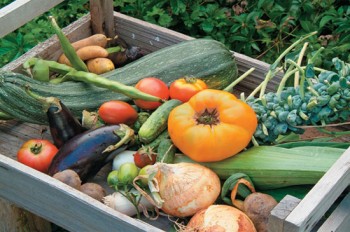 Now that you’ve decided to take the plunge and start growing your own delicious, organic vegetables let’s get started with the basics of vegetable garden design. Where will I put it?
Now that you’ve decided to take the plunge and start growing your own delicious, organic vegetables let’s get started with the basics of vegetable garden design. Where will I put it?
The first decision you need to make is the best position to build your vegetable garden. The best position is an area either north or north east to maximise sunlight and well away from the root systems of large trees and shrubs, to avoid competition for the nutrients that will make your vegetable garden thrive.
What is the best vegetable garden design?
For those of you building your vegetable garden from scratch and with the luxury of some garden space we advise that raised garden beds, no more than twice the length of your arm are the best option. We suggest that you use non-toxic materials to avoid chemical leaching over time. A good alternative to treated pine is one of the new eco wood products that are made from 100% high and low grade mixed plastics and is a great sustainable alternative to timber.
Building a raised vegetable garden has several advantages:
• The vegetables are at a more accessible height, making life a little easier
• You can easily reach everything when planting or harvesting
• You are not treading all over the soil and compacting it
• You can use imported premium quality soil mix for better growth
• Better drainage
• The soil warms up more quickly in spring
• It is easier to control invasive weeds
• It provides a barrier to pests such as slugs and snails
What next?
Once you have constructed your vegetable garden bed put a thick layer of newspaper on the bottom to kill off any residual weeds, fill the garden bed with premium imported soil mix, dig in compost, organic matter and manure, add some slow release fertilizer, water the garden bed thoroughly and now you’re ready for planting.
What should I plant?
This is the fun part where you can choose your favourite herbs and vegetables and get started! There are hundreds to choose from and you will be guided by the seasons and the climatic conditions where you live.
Here are just a few seasonal choices to get you started:
Winter – asparagus, garlic, shallots, onions, rhubarb, lettuce, peas, silver beet, spinach, Asian vegetables, horseradish, broad beans and leeks
Spring – carrots, cabbage, herbs, beetroot, cherry tomatoes, tomatoes, lettuces, cucumbers, capsicum, eggplant, zucchini, spring onion, silver beet, peas, water chestnuts, ginger, potatoes, rocket, Asian vegetables
Summer – beetroot, brussel sprouts, cabbage, cauliflower, carrots, celery, Chinese cabbage, cucumber, endive, lettuces, parsnips, radish, silver beet, squash, sweet corn, tomatoes
Autumn – beetroot, broccoli, cabbage, carrots, Asian greens, cress, leeks, lettuces, onions, parsley, peas, radish, rocket, shallots, spinach, swedes, turnips
Happy gardening!
















